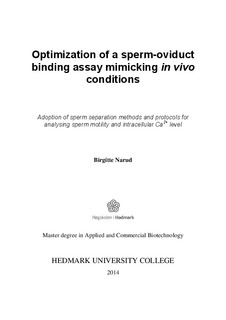Optimization of a sperm-oviduct binding assay mimicking in vivo conditions. Adoption of sperm separation methods and protocols for analysing sperm motility and intracellular Ca2+ level
Master thesis

Åpne
Permanent lenke
http://hdl.handle.net/11250/225367Utgivelsesdato
2014Metadata
Vis full innførselSammendrag
English:
An in vitro model that mimics the interactions between spermatozoa and oviductal epithelial cells can be used to increase the knowledge about the function of the oviduct and the formation of a sperm reservoir in vivo. The aim of the present study was to optimize methods for culturing bovine epithelial cells (BOECs) bi-dimensionally on plastic and three-dimensionally on polyester membrane. These cells were used in a sperm binding assay for evaluation of sperm-BOEC binding and release capacity. In order to measure multiple sperm attributes of the cells evaluated in the binding assay, adaption of protocols for evaluation of sperm motility parameters by CASA and intracellular Ca2+ level by flow cytometry analysis was performed. In addition, the effect of separating sperm cells by Percoll® and BoviPure® centrifugation was evaluated measuring sperm viability, acrosome integrity, motility, intracellular Ca2+ level, total ATP content and sperm-BOEC binding and release capacity. Findings demonstrated that 1·106 sperm cells/ml is an optimal sperm concentration for the BOEC binding and release assay, and epithelial cells from both ipsi- and contra-lateral oviducts can be used for culturing. BOECs cultured on collagen coated polyester membrane have a more in vivo like structure than BOECs cultured on plastic, allowing a more specific binding of sperm cells to the monolayers. In addition, our results showed that BoviPure® and Percoll® centrifugation improved the quality of the separated sperm population. However, the degree of improvement varied between the parameters analysed. BoviPure® and Percoll® centrifuged sperm cells had a higher binding capacity to in vitro cultured BOECs, with highest binding capacity for BoviPure®. These findings suggest that BoviPure® is an acceptable alternative to Percoll® for separating bull sperm and for use in the sperm-BOEC binding and release assay. However, both methods can be used to mitigate the sperm viability differences in the binding assay.
Beskrivelse
Mastergradsoppgave i næringsrettet bioteknologi, Avdeling for lærerutdanning og naturvitenskap, Høgskolen i Hedmark, 2014. Master of applied and commercial biotechnology.